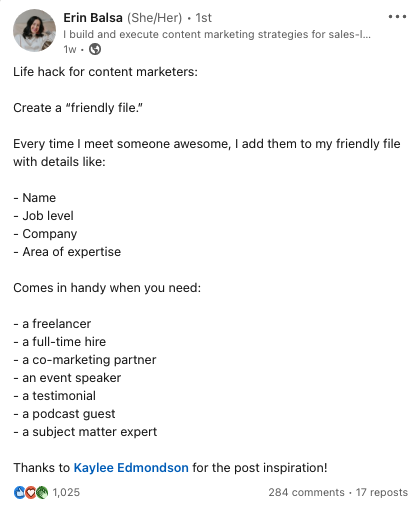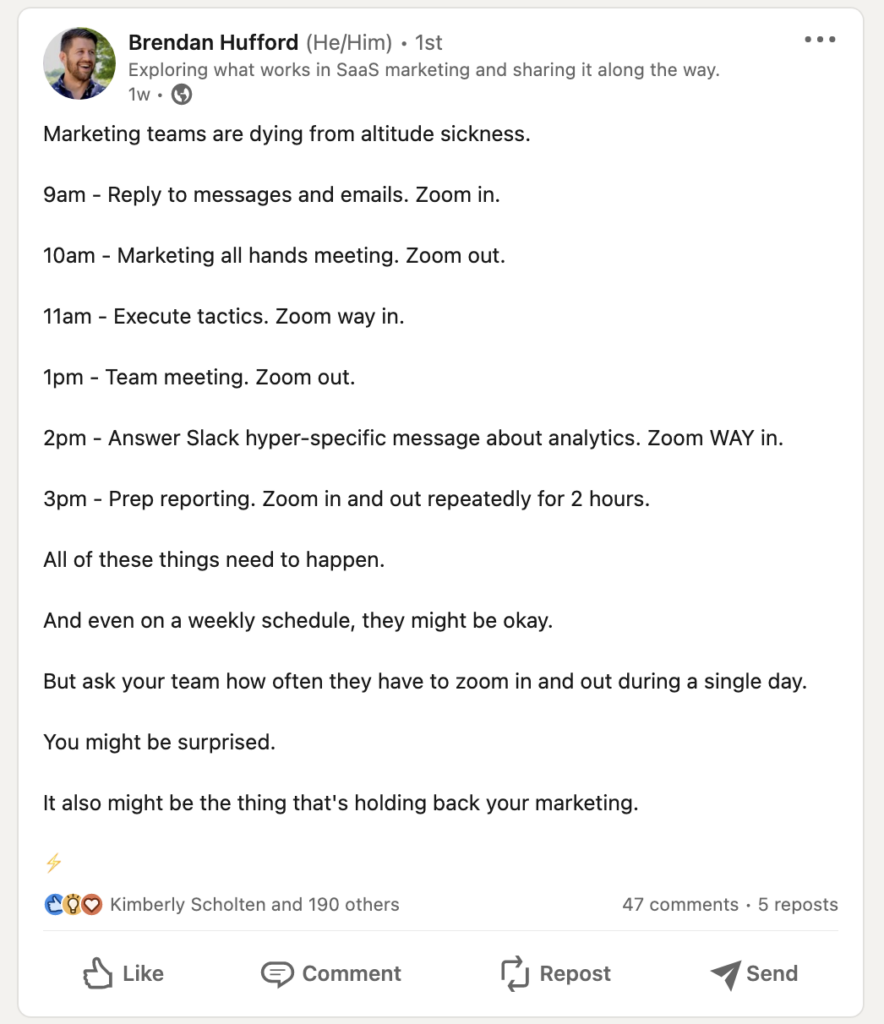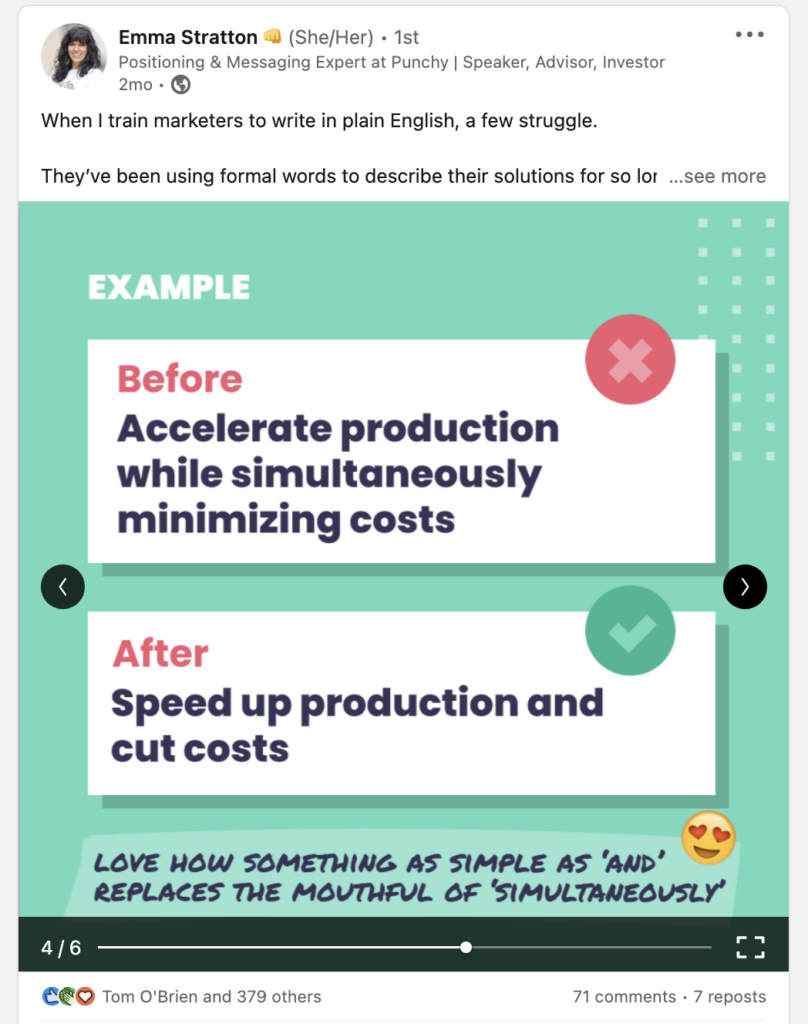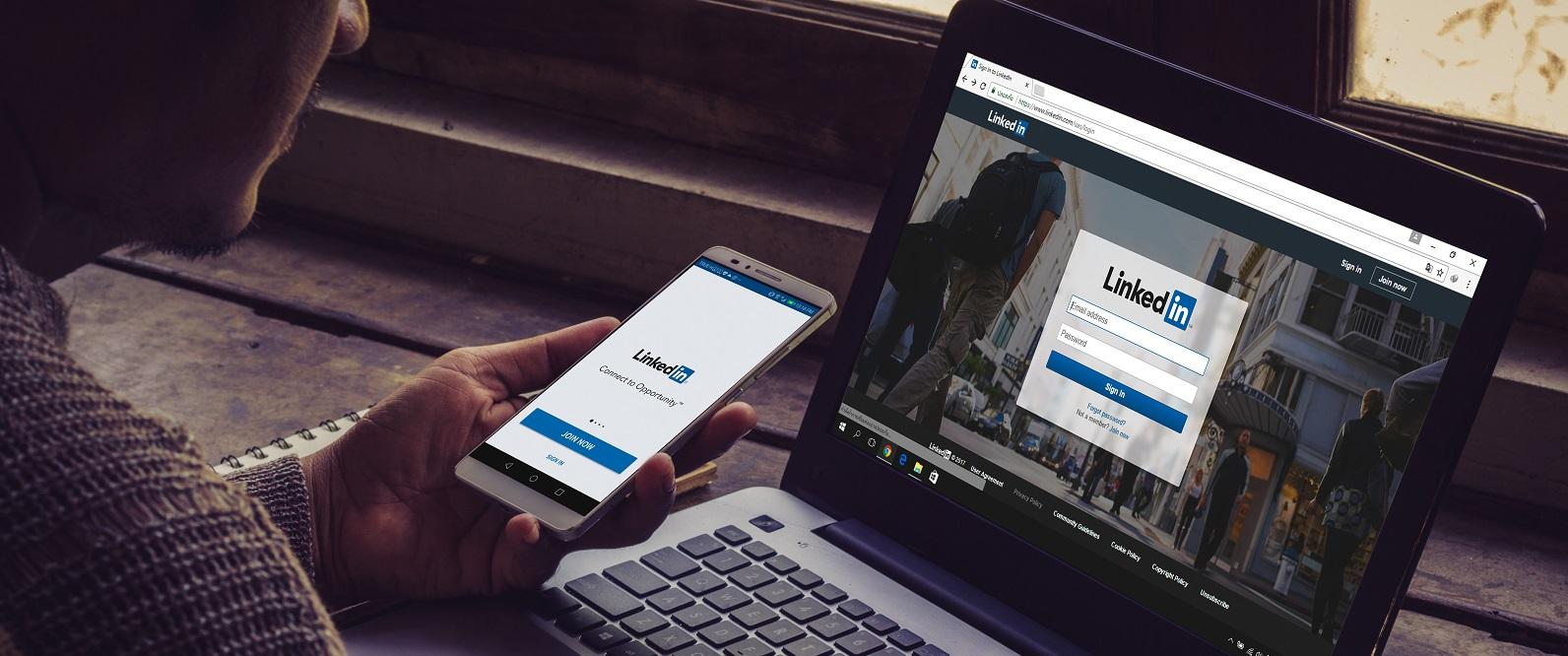B2B marketers get it — LinkedIn is the platform where their customers are spending time, connecting, and reading content. Unlike other platforms (ahem, Facebook), the dream of organic reach is alive and well on LinkedIn. According to its own internal data, LinkedIn has seen double-digit increases in organic engagement and public conversations over the last few years. That’s why, according to research from the Content Marketing Institute, a whopping 96% of B2B marketers use LinkedIn—and 60% say it’s “extremely” or “very” effective.

But, as the platform grows in popularity, you need to try a little harder to make your posts stand out from the crowd. (Just not in the way that ends up with a screenshot on the Lunatics of LinkedIn subreddit.)
The secret to LinkedIn success is pretty simple. Most people who have found it offer the same advice:
- Post consistently, about topics you know and care about.
- Be authentic and share real-life experiences.
- Engage with other people’s content.
But when it comes down to actually writing a post, that blank little box can be intimidating. So in this article, we’re covering five specific tips for writing effective LinkedIn posts that will reach your audience, grab their attention, and keep them coming back for more.
A little context: We’re talking about individual pages and posts here. Your official company page is a great place to distribute content, run paid campaigns, and showcase your culture. But the real magic on LinkedIn happens when a real human interacts with other real humans in a meaningful way. And when employees build up a personal following and become viewed as a thought leader, that makes the company listed in their bio look pretty darn appealing by association.
LinkedIn Tip #1: Lower the reading level — and keep it simple
We don’t want to insult your audience. But the LinkedIn posts that tend to perform best are simple and easy to read. This is not the place to post your academic treatise. (Unless your target audience is academics who love treatises, in which case, skip ahead.)
So keep it simple. If that doesn’t come naturally, use a readability editor like the Hemingway App or Microsoft Word’s built-in Flesch-Kincaid scoring tool. When you use the “Xth-grade reading level” scale, a good rule of thumb is to shoot a few grades below your target audience’s formal education level.
As for length, currently, LinkedIn posts have a limit of 3000 characters. That’s somewhere in the neighborhood of 500-600 words, which is way more than you need to share your average status update. And posts are truncated after 140 characters, so users have to click a “See More” button to read the rest (our next tip covers making that happen).
So how long should a LinkedIn post be? As always in marketing, put the user first. People come to LinkedIn to scroll along and consume short form content. So use as many words as you need to get your point across—and no more.
LinkedIn Tip #2: Finesse your opening line
On LinkedIn, the opening sentence of your post doubles as your headline. And as advertising legend David Ogilvy once said, “On the average, five times as many people read the headline as read the body copy. When you have written your headline, you have spent 80 cents out of your dollar.”
So make sure your first line or two grabs attention and compels your reader to click that little “See More” link to open and read the rest of your post.
Here are some real-life examples of eye-catching opening lines—and how you can take inspiration for your own posts:
“My biggest rookie mistake was 𝘳𝘦𝘢𝘭𝘭𝘺 cringey. Here’s what happened.”
– Jess Cook, starting her post with a personal anecdote, aka, LinkedIn catnip
“What the hell happened to blog posts? I feel like the places where I consume the best content right now are not on blogs.”
– John Bonini, sharing a hot take, and making sure to back it up with a solid argument
“There are few worse feelings than a case of serious buyer’s remorse during your first week or two at a new job.”
– Ashley Amber Sava, nailing a compelling metaphor, which catches attention by framing a familiar concept in a new way.
LinkedIn Tip #3: Jump on the latest bandwagon
Jumping on the latest bandwagon is usually bad marketing advice. But on LinkedIn, it will probably pay off.
That’s because the LinkedIn algorithm dictates what content appears in users’ feeds. And while nobody knows exactly what ingredients make up the secret sauce, we can deduce that algorithm is constantly recalibrated.
At the same time, LinkedIn likes to experiment with new content types. Sometimes those features fail, like LinkedIn Answers or LinkedIn Stories. Sometimes their popularity wanes or reach declines, like LinkedIn Articles.
But when new features and content types are launched, the platform algorithm tends to reward the early adopters by boosting the organic reach of these new post types. That’s why your favorite LinkedIn-fluencers all seem to start posting polls, or PDF carousels, or whatever flashy new format is available, at the same time. They know the algorithm overlords will favor their experimental new content.
So go ahead — hop on that bandwagon. Experiment with the latest content feature. You’ll probably see some positive results, at least for a while. Just don’t rebuild your whole marketing strategy around the latest trend. That is always bad marketing advice.
LinkedIn Tip #4: A little visual interest goes a long way
We know you came here for tips on how to write a good LinkedIn post. And this isn’t Instagram. Words still rule the roost on LinkedIn.
But images, video, and other visual content are worth including, at least every once in a while. For one thing, they liven up your profile page when people go to check out your content. For another, the engagement numbers don’t lie:
- Posts with videos are 20x more likely to be shared than other types of posts
- Posts with images typically see a 98% higher comment rate than those without
- Native documents — PDF carousels that you upload directly to LinkedIn — generate 3x more clicks than other types of content
So when you have a bit more time to spend crafting your perfect LinkedIn post, consider adding a photo, a meme, an infographic, a screenshot, or even just an emoji or two. You really will find a little visual interest goes a long way.
Tip 5: Write for an audience of one
This last tip isn’t about gaming the LinkedIn algorithm or hacking the feed. It’s just a good writing tip.
Once you have an idea for a post—maybe a story about a time you learned a hard lesson, or your spiciest take on remote work, or an actionable tip about succeeding in your industry—think about the person in your network you’d most want to read it.
Picture the exact coworker, peer, customer, manager, whomever you think could really find value in what you have to say. (And if you can’t, you probably need to come up with a different idea.)
Now, write your post as though you’re talking to them. Then, read it out loud. Simplify any parts that make you stumble or sound unnatural. Hit publish.
And sit back to see how content written for an audience of one tends to resonate with a whole lot more.
Examples of Standout LinkedIn Posts
Now, let’s bring all these best practices for LinkedIn posts together and look at a few examples of posts we love.
LinkedIn Post Example #1

Fun fact: This post from content marketing leader Erin Balsa started as a comment she left on another marketer’s post. But instead of resharing the original post, she came up with her own post on the same topic (and tagged the OG writer to give her credit).
Takeaways:
- Catchy opening lines make you want to read more
- Bullet-point lists are easy to scan and read
- Good tips, like Erin’s, are simple and actionable
LinkedIn Post Example #2

Growth marketer Brendan Hufford uses some powerhouse tactics here, like an intriguing metaphor in the opening line and an easily scannable but engaging format. It’s easy to picture him writing to an audience of one with this post—maybe even a former boss. But, his post is relevant to almost any working professional, regardless of discipline or seniority level. And his comments are full of people sharing their firsthand experiences and ideas about how to make this problem better.
Takeaways:
- Playing with format keeps things interesting—in this case, using a daily schedule for the bulk of the post
- List-style posts are easy to scan (it bears repeating)
- Bringing familiar concepts to life in an unexpected way starts conversations
LinkedIn Post Example #3

Messaging and positioning expert Emma Stratton uses LinkedIn carousels in smart, practical ways (and gets that experimental content bump from the algorithm while she can). Her tips on simplifying language are easy to read and put into action thanks to helpful before-and-after examples.
Takeaways:
- Examples make how-to advice come to life
- Carousel posts add visual interest to your feed
- Helpful text gives context to visual content
- Clear CTAs help readers follow more of your content (Emma includes her newsletter signup link in the comments of every post)
A Few Last Words About LinkedIn Posting Best Practices
Bottom line: the best way to get better at posting on LinkedIn is to start posting on LinkedIn. If your own status updates are too intimidating, start by commenting on other people’s posts and reposting your favorites. Then, when an idea hits you, write your own take. And just keep doing it. (Just be sure to avoid these top LinkedIn no-nos).
See what topics your network cares about, experiment with different post lengths and formats, and pay attention to which posts perform well and which ones fall flat. You’ll find your rhythm, and your people. Ready for more expert tips? Need to expand your efforts to your company page? Check out our ebook “10 Things B2B Companies Should Be Doing on LinkedIn”.
